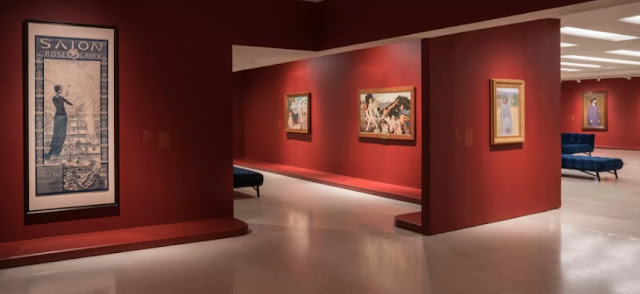Anche
il Guggenheim di New York guarda al passato e lo fa in modo mistico
con una bella mostra sul simbolismo, focalizzandola nel suo momento
più creativo fra gli anni 1892 e 1897 quando si realizzarono dei
“salon” appositi a Parigi. La mostra giungerà in autunno a
Venezia.
CS
From
June 30 through October 4, 2017, the Solomon R. Guggenheim Museum
will present Mystical Symbolism: The Salon de la Rose+Croix in Paris,
1892–1897, the first museum exhibition on this revelatory and
significant yet frequently overlooked series of Salons. Mysterious,
mythical, and visionary themes, often drawn from literature,
prevailed in the art of the six exhibitions, which were held annually
in Paris from 1892 to 1897. Images of femmes fragiles and fatales,
androgynous creatures, chimeras, and incubi were the norm, as were
sinuous lines, attenuated figures, and anti-naturalistic forms.
Featuring highlights from the Salons, the Guggenheim exhibition will
include approximately forty works by a cross section of artists—some
familiar, others less so—and invite a fresh look at and new
scholarship on the legacies of late nineteenth-century Symbolist art.
Mystical
Symbolism is organized by Vivien Greene, Senior Curator, 19th- and
Early 20th-Century Art, with the assistance of Ylinka Barotto,
Assistant Curator, Solomon R. Guggenheim Museum. Following its New
York presentation, the exhibition will travel to the Peggy Guggenheim
Collection, Venice, from October 28, 2017–January 7, 2018.In the
spring of 1892 Joséphin Péladan (1858–1918), author, critic, and
Rosicrucian, organized the first Salon de la Rose+Croix at the
Galerie Durand-Ruel in Paris. Showcasing mystical Symbolist art,
particularly a hermetic and spiritually devoted vein favored by the
eccentric Péladan, the annual Salons were cosmopolitan in reach and
served as a crossroads, gathering the work of artists from Belgium,
Finland, France, Italy, the Netherlands, Spain, and Switzerland.
Benefiting from extensive research to identify artworks shown in the
original exhibitions, Mystical Symbolism will encompass painting,
work on paper, and sculpture by artists such as Antoine Bourdelle,
Rogelio de Egusquiza, Jean Delville, Charles Filiger, Ferdinand
Hodler, Fernand Khnopff, Alphonse Osbert, Armand Point, Georges
Rouault, Carlos Schwabe, Alexandre Séon, Jan Toorop, Ville Vallgren,
and Félix Vallotton.
Mystical
Symbolism provides an opportunity to explore the diverse and
sometimes opposing concepts that informed Symbolism in the 1890s.
Hinging on central artworks shown at each Salon, the exhibition will
tease out seminal tropes, such as the role of Orpheus, adulation of
the 15th-century early Renaissance Italian painters known as the
Primitives, and the cult of personality that developed around figures
including Richard Wagner and Péladan himself. Accompanied by
historical documents and set in galleries adorned with lush
furnishings, the exhibition conveys the spirit of the Salon
experience. A musical component with work by Erik Satie and others
underscores the key role occupied by composers for the movement.
Previous
exhibitions on the Symbolist movement have focused primarily on a
nationality or a broad theme, rather than on a specific event like
the cultish Péladan’s Salon de la Rose+Croix. The participants’
diverging ideologies, ranging from politically conservative and
Catholic to radically anarchist and anti-clerical, reveal how the
varied approaches are dialectically related to the sacred and
spiritual philosophies that constituted Symbolist art. By tracing the
means through which the Salon proposed these impulses, the Guggenheim
exhibition investigates the Symbolist precepts attendant in
modernism.
The
fully illustrated exhibition catalogue will offer new scholarship on
the Salon de la Rose+Croix and Symbolism. It will be comprised of
essays on the Salon and its main themes (Vivien Greene, Senior
Curator, 19th- and Early 20th-Century Art, Solomon R. Guggenheim
Museum, New York), the contemporary reception of the salon
(Jean-David Jumeau-Lafond, independent scholar), and the connections
between Symbolists tenets and those of early 20th-century avant-garde
artists (Kenneth E. Silver, Professor of Art History, New York
University). The catalogue will also contain a selected bibliography
and artist entries authored by emerging scholars.
Furniture
courtesy of Roche Bobois.
Info
guggenheim.org
#GuggMystical



